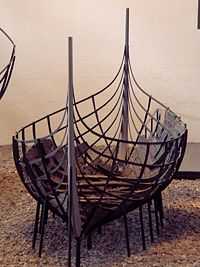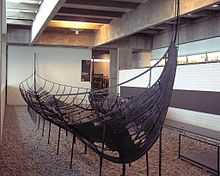Skuldelev ships

The Skuldelev ships is a term used for 5 Viking ships recovered from Peberrenden by Skuldelev, c. 20 km north of Roskilde in Denmark. In 1962, the remains of the ships were excavated over 4 months. The recovered pieces constitute 5 types of ships and have been dated to the 11th century. They were allegedly sunk to prevent attacks from the sea.[1]
Information on "Skuldelev 4" is omitted, as the discovery of a fourth ship was found to be a part of Skuldelev 2.[2] The Skuldelev ships, which provide a good source of information about the shipbuilding traditions of the late Viking period, are today exhibited at the Viking Ship Museum in Roskilde.
Description
Skuldelev 1
Skuldelev 1 is a sturdy seagoing cargo-vessel, possibly of the knarr type. It is 16 m long and 4.8 m wide and would have had a crew of 6 to 8. The ship, which is built from pine and oak, was constructed in western Norway,[3] and has seen repairs in eastern Denmark.
Skuldelev 2

Skuldelev 2 is an oak-built, seagoing warship. It is a longship, possibly of the skeid type. It is approximately 30 m long and 3.8 m wide, and would have had a crew of 70-80. Dendrochronology showed that the ship was built in the Dublin area around 1042. The shape of the ship would have allowed for great speed, up to 15 knots (28 km/h) with a rowing crew of 60 and more while under sail. It is one of the longest Viking-ships ever found.
A reconstruction of this ship: The Sea Stallion from Glendalough (in Danish: Havhingsten) has been built by the Viking Ship Museum in Roskilde and sailed to Dublin during the summer of 2007 (arriving on 14 August). The ship was on exhibit in Dublin until the summer of 2008 at which time it was sailed back to Roskilde (arrived on August 9).[4]
Skuldelev 3

The Skuldelev 3 is a 14 m long and 3.3 m wide cargo ship, possibly of the byrding type. It is made from oak, and was constructed somewhere in Denmark. It would have been well-suited to shorter journeys in Danish waters and the Baltic Sea, it would have held a crew of 5-6 and could reach a top-speed of 8.5 knots (16 km/h) under sail.
Skuldelev 4
The Skuldelev 2 was originally thought to be two different ships, named Skuldelev 2 and 4. During the excavation it was discovered that they were in fact one long ship, hence the name Skuldelev 4 was stricken.
Skuldelev 5

Skuldelev 5 is a small warship of the snekkja type. It is 17.3 m long and 2.5 m wide and would have had a crew of about 30. It is made from oak, pine and ash, and was built in the Roskilde area. The ship was purpose-built for sailing in Danish waters and the Baltic Sea, and the top speed was calculated to have been about 6 knots (11 km/h).
However, the first-ever replica of this ship which was Sebbe Als of Augustenborg, Denmark showed these calculations to be wrong. Sebbe Als is able to reach a speed of 5 knots (9 km/h) on oars alone, and under sail she does 12 knots (22 km/h).
Skuldelev 6
Skuldelev 6 is an 11.2 m long and 2.5 m wide cargo and fishing-vessel of the ferja type. It was built in Sognefjorden in western Norway, mainly from pine. It would have had a crew of 12-14.
References
- ↑ BBC Ancient history in-depth: Viking dig reports
- ↑ Crumlin-Pedersen, Ole (2002). The Skuldelev Ships I. The Viking Ship Museum and the National Museum of Denmark.
- ↑ http://www.vikingeskibsmuseet.dk/en/exhibitions/the-skuldelev-ships/skuldelev-1/#.UrHQkxYlPq8
- ↑ "Havhingsten fra Glendalough (Skuldelev 2)". Retrieved 14 December 2011.